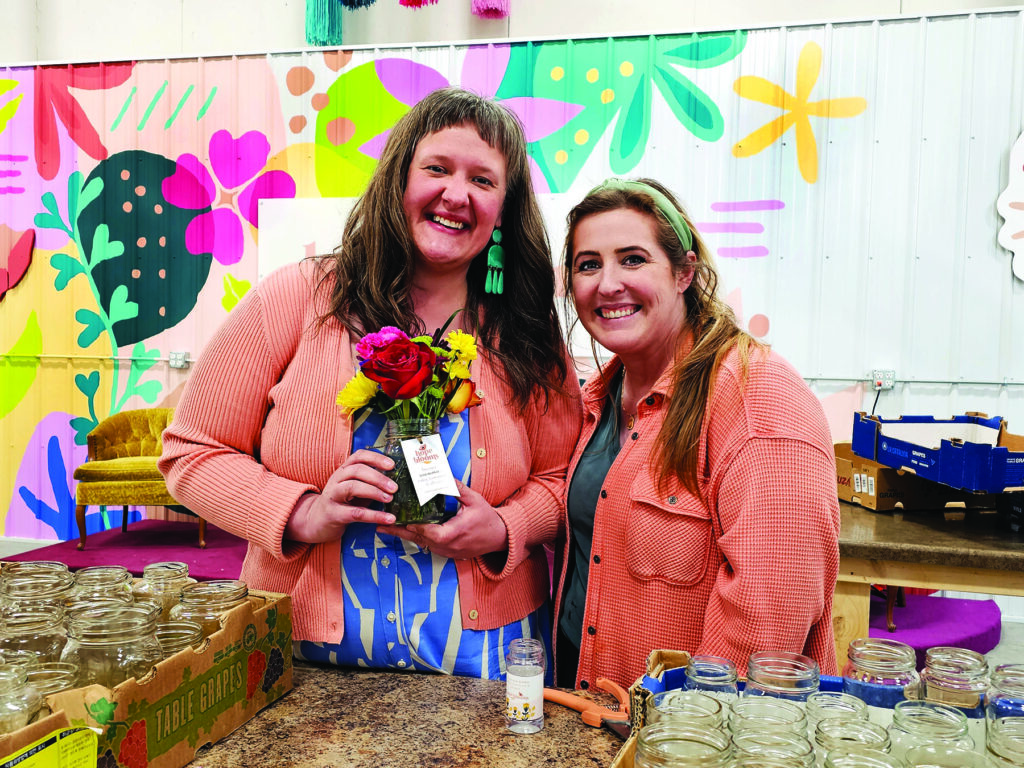Nancy Edmonds Hanson

Founder Kelly Krenzel and Katie Gehring of Hope Blooms. Photos/Nancy Hanson.
The most elegant floral arrangements usually live for just a day, adding grace to a wedding, perhaps, or a funeral before they’re sadly sent to the landfill. Hope Blooms gives them a second lease on life – bringing smiles all across the community to those who most need a day-brightening boost.
“We’re joy peddlers and kindness spreaders,” Kelly Krenzel says. “By repurposing and sharing those flowers, we’re bringing the message of belonging and fostering joy among those who need it most.”
She’s talking about Hope Blooms, the nonprofit she founded in her basement seven years ago. The former Hospice of the Red River Valley staffer was home with newborn Henry, the older of her two sons, and was looking for new purpose … for herself and, after brainstorming with a florist friend, for the gorgeous bouquets that had served their one-time purpose.
“I had the urge to do something tangible to give back,” she explains. “I brought the idea to my friend Christy Tehven, who had just opened her flower shop, Love Always Floral. She started asking her brides about donating their flowers after their weddings. I moved the furniture in my basement, set up a work area with two sawhorses, recycled some empty food jars … and when one of Christy’s brides said ‘yes,’ I’d put out the word to my friends.”
When the new mom had a moment, she and her husband, along with those friends, delivered the little bouquets to people who’d benefit from knowing someone cared. She concentrated on the elderly residents of nursing homes, memory care centers and assisted living facilities, as well as people with long-term illnesses or in hospice care and others who, Kelly says, “may be disenfranchised, lonely or just need extra support.”
How the enterprise has grown! Today, Hope Blooms – now incorporated as a nonprofit – collects, arranges and delivers bouquets to nearly 100 living centers in Moorhead, Fargo and West Fargo. In the days since its humble beginnings, the organization and its volunteers have delivered more than 67,000 bouquets – some 22,000 last year alone. Volunteers have put in more than 13,000 hour collecting and dismantling previously admired arrangements, sorting and refreshing the blossoms, scavenging and washing the 8- to 12-ounce glass jars that serve as vases, and delivering the finished bouquets to make the day for older men and women by reminding them they are never forgotten.
Katie Gehring, the only full-time employee, joined Hope Blooms in October. A veteran of nearly 10 years in the floral industry, she serves as the organization’s operations and development manager. “We’re 100% community funded,” she says. “We count on donations of gently used or fresh-cut flowers, but also supplies and the funds we need for basic expenses and to rent our space” (in a warehouse in north Fargo) “and pay basic expenses.” Along with monetary donations, including memorials and tribute gifts, donors can sponsor a week of bouquet deliveries, and share pint-sized canning jars, jute twine and cleaning supplies. In summer, local gardeners also share the floral bounty of their own back-yard gardens.
Kelly credits long, happy summer days with her Grandma Freda for her appreciation for flowers. Growing up in Bismarck, she spent long days at her grandmother’s side tending rows of blooms in her garden. Her empathy for older people was growing, too. “This is truly the smallest good thing that we can do to brighten someone’s day,” she observes. “Our deliveries, in person, are drops in the kindness bucket. Eventually it overflows, creating ripples of kindness.”
Hope Blooms hosts about 300 flower-arranging events over the course of a year, from 25 to 30 every week in their workshops. Drivers gather used flowers and, at the end of the day, bring them out to unsuspecting recipients. Several volunteers, Kelly or Katie make each presentation, going through the halls and knocking on doors to personally distribute the lovely surprises.
Kelly and Katie emphasize that Hope Blooms does not compete with local florists. Instead, they’re an important source of the flowers they give away. “Sometimes we get inquiries from other nonprofits, asking whether we can supply table arrangements for fund-raising events. We cannot,” Kelly emphasizes. Nor do they fulfill one-off requests for bouquets.
A secondary benefit has grown out of Hope Blooms’ mission to bring its message of belonging into the community. Creating bouquets has proven to also build teams and friendships. Newcomers are always welcome to get involved, both as individuals and groups. More information on upcoming events can be found at www.hopeblooms.org. The website also carries details of upcoming classes like “Mommy and Me” bouquet-making May 18 and 20 and one-of-a-kind dried floral monogram hoops July 20 and 21.
Speaking from experience, Kelly declares that Hope Blooms’ floral mission is good for the soul: “Research shows that people who are around flowers are three times happier. It reduces anxiety and stress and increases cognitive ability. We need food, but we also need connection with other people.”
She adds, “We live in such a beautiful, generous community. I don’t think this could have been planted or grown as well in any other place. We’re proud to play a role in building the kind of place we all want to be a part of.
“These small, selfless acts of kindness have the power to change the world.”


